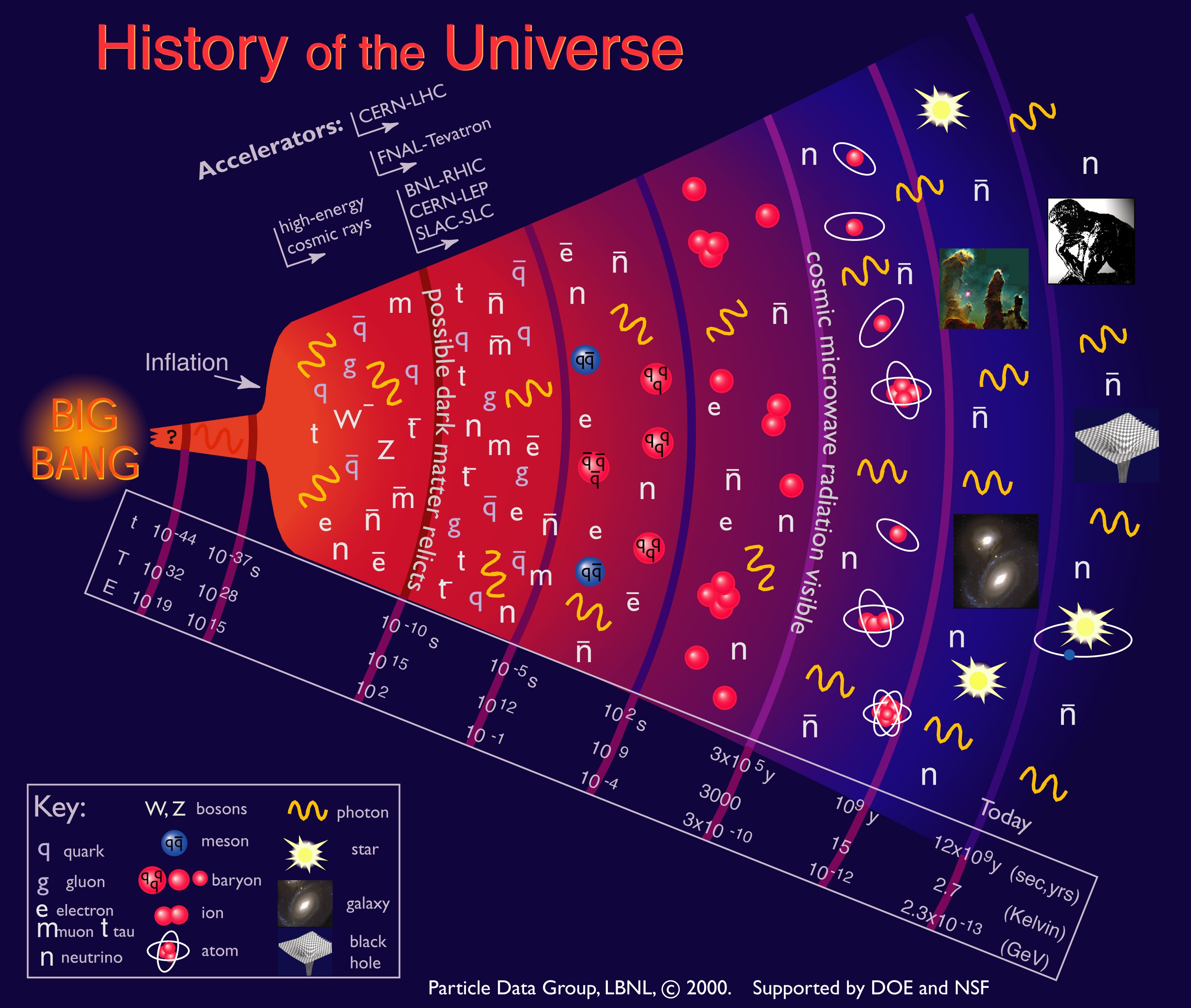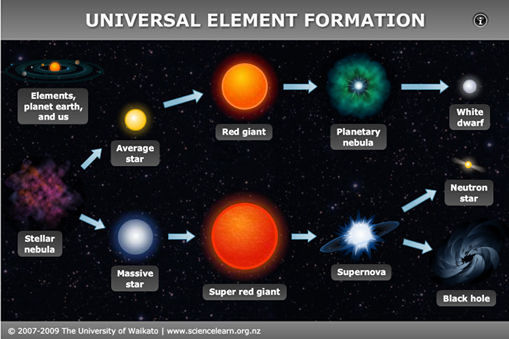a) Apart from the “immediate” neighborhood of our Milky Way Galaxy,
in any direction you look, the further away a galaxy is, the greater the shift
of its spectral lines towards longer wavelengths (e.g., towards the red portion of the spectrum, hence the term “red-shifted.”) This systematic red-shift of extragalactic spectra
was first discovered nearly a hundred years ago, by combining spectra obtained
by V.V. Slipher at Lowell Observatory with distance determinations obtained by
E. Hubble at Mt. Wilson Observatory.
Any cosmological theory must explain this observational fact. According
to the Big Bang theory, the observed red-shifts are a direct consequence of
the expansion of the Universe since the Big Bang (13.7 billion years ago).
As space(time) expands, the light-waves stretch with the space they are in,
meaning their wavelengths get longer, or red-shifted.
Timeline of the universe, showing the formation of particles, then nebula, then more.
b) There is remnant radiation observed in all directions of space, corresponding
to a temperature of 2.73 Kelvins (above absolute zero), peaking at a wavelength of
~1 millimeter, which is in the “microwave” region of the electromagnetic spectrum.
Any cosmological theory must explain why we see this radiation uniformly
in all directions in the sky. According to the Big Bang theory, early in the
Universe’s history, its state was extremely hot and dense–so hot that
protons and electrons were separated from each other in a state
known as a “plasma.” Photons (light) cannot escape such a plasma,
since photons strongly interact with free electrons and protons. This
interaction is called “scattering.” As the Universe expands, it cools. Once the Universe
had expanded and cooled enough so that protons and electrons
could combine to form atoms, the plasma turned into an electrically
neutral state, and the photons could escape–so instead of a dense, opaque
fog of scattered photons, we have a transparent state of freely propagating photons (light).
The microwave background radiation was discovered (accidentally) by some radio
communications engineers (as a source of unwanted noise in their communications
equipment). They received the Nobel Prize in Physics for their discovery.
c) We observe the elemental abundances in the Universe to be
~90% (by number) hydrogen and ~10% (by number) helium.
In terms of mass, this corresponds to ~75% by mass of hydrogen and ~24% by mass
helium. All the other elements we are familiar with here on Earth are trace
elements relative to these, on the scale of stars, galaxies, and galaxy clusters.
The abundances of hydrogen and helium are predicted by the Big Bang theory
in terms of what is known as “Big Bang nucleosynthesis.”
2. Did all of the elements form at once with the Big Bang? And if not, in what order (if any) did they form in?
The nucleon formation order in the Big Bang was: protons (protons are nuclei
of hydrogen) and neutrons, then deuterons (the nuclei of deuterium or heavy
water), then helium nuclei (both “light” helium, with 2 protons+1 neutron and “regular” helium, with 2 protons + 2 neutrons), then lithium. All the tritium nuclei (12 yr half-life) and beryllium nuclei (53 day half-life) formed in the Big Bang decayed into deuterons or lithium.
All other elements are formed either within massive stars, post-main-sequence stars, supernovae, or spallation of cosmic particles and interstellar hydrogen nuclei (protons).
3. Would it be theoretically possible to create even more elements?
Yes, elements past uranium, the so-called “trans-uranium” elements
are all formed in the lab with accelerators. Generally, these very heavy
elements are unstable and decay (their nuclei split apart, or undergo “fission”)
in fractions of a second.
4. What elements are “stardust” and nebulae primarily composed of?
Interstellar dust is mainly composed of silicates and hydrocarbons.
Nebulae are generally gas lit up by a nearby light source, which could be
a massive star or star cluster (e.g., Orion nebula) , a white dwarf (planetary
nebulae), a pulsar (Crab nebula), or very young star (L1551 in Taurus).
Interstellar gas is primarily composed of hydrogen and helium, with traces of
other, heavier elements.
A flowchart of star formation; protostars aren’t shown in this chart, but would be between the stellar nebula and a fully-formed star.
6. What are neutron stars?
A neutron star is an object made entirely of neutrons, that has a radius of ~10 km
and contains more than 1.4 solar masses. Generally, it is a remnant of a
supernova explosion.
7. And what are protostars?
A protostar (of which I am one of the co-discoverers) is an object
which is still in the process of forming, with almost all of its mass residing
in an extended (~2000 Earth-Sun distances, or astronomical units) infalling envelope.
Its energy is derived from gravitational infall, and it fuels powerful bipolar
jets of gas, which act to remove its magnetic field and spin energy.
7. You’re currently studying a protostar, the Wasp-Waist Nebula, right? What do scientists hope to learn from protostars, and for what purposes?
Fantastic! You saw it! Yes, this nebula is mostly composed of hydrogen.
The protostar forming at the center of the Wasp-Waist Nebula may be the
first such object we have found that ultimately may form into a “failed star”
or “brown dwarf” (an object not massive enough to fuse hydrogen into helium
in its core) instead of into a low-mass star.
We’re hoping to understand, in detail, both how stars form from the
tenuous interstellar medium and how their planetary systems form.
The Wasp-Waist Nebula, which holds a protostar currently being studied.
8. Do orbiting planets form already orbiting a star? Or do they form, and then drift in space until a sizeable star is encountered?
Actually, as stars form they form accretion disks, as well. Just like when
water goes down a drain, it generally swirls around before going down the center,
so gas and dust swirl around in a disk around the central protostar before falling in.
Planets eventually form from the disk orbiting the central young (pre-main-sequence,
or, not yet fusing hydrogen to helium) object.
9. Why are the outer planets all gas giants while the inner planets are all rock?
That has to do with the temperature structure of the accretion disk
around a young, pre-main-sequence object. It’s so hot close-in that only
rocky (silicates, iron) planets can form from planetesimals crashing into each other–it’s too
hot for ices to form. Remember that, by far, most of the material in such
a disk is hydrogen, then helium, with just traces of heavier elements.
Far enough out in the disk, the temperature cools enough so that both
ices (composed of water, carbon monoxide, ammonia) and rocks (silicates)
can form the central cores of planets. Once an icy/rocky core
surpasses about ten Earth masses, its gravitational pull can become
strong enough to hold onto and sweep up the disk’s gas in and near its orbit.
This is how the gas giants Jupiter and Saturn, and the ice giants, Neptune and
Uranus, formed.
10. Is it difficult to study the formations of stars and planets? What obstacles are in the way of studying these formations?
Yes, it’s difficult, but it’s rewarding. We are very lucky to live in the present
time, when our technology is allowing us to examine star and planet formation
in unprecedented detail. The ALMA (Atacama Large Millimeter/submillimeter Array)
will revolutionize our understanding of this field. This instrument (66 telescopes
11. What kind of technology are scientists using to study these formations?
Very many kinds. The ALMA array, for instance, uses the fastest, specially
made supercomputer (called a “correlator”) to process the signals from
all of its antennas simultaneously every 10 seconds. The receivers for
detecting radiation from the sky are state-of-the-art and are approaching (or at) the
quantum limit for how faint a signal they will respond to. Its data processing
software and user interface is brand new and continually being written and upgraded.
This is a truly international collaboration, with scientists from Europe,
North America, Taiwan, and Japan all equal partners in its use and development.
For near-infrared arrays, to find new brown dwarfs
and young free-floating planets, we’re using the largest such devices in existence.
For near-infrared spectroscopy, we’re using a 400-fiber-optic fed
spectrograph (called FMOS) on the Subaru 8.0-meter telescope on Mauna Kea.
for a recent synopsis of this work).
We’re looking forward to JWST, the successor to Hubble, which will
work in the near- and mid-infrared. That is where we can study star and planet
formation much better than at optical wavelengths, where these objects
are generally invisible.
12. How do SETI scientists try to find life in the universe?
Currently, they are using the ATA (Allen Telescope Array),
looking in a specific frequency range (1-10 GHz) for
narrowband signals that might be transmitted by other
SETI scientists are also studying geology, geophysics, atmospheric
science, and the conditions under which life may first have arisen on our own planet.
They are studying life in extreme environments on Earth, as in under the Antarctic
ice sheet and on the deep ocean floor where sunlight does not penetrate, and pressures
are high, etc.
13. You’re very involved in different fields of astrophysics; how did you realize your interest in astronomy?
I remember as a little girl of 4 or 5 years old, looking up at the dark sky, seeing the
stars, and wondering.
The night sky over the Church of Good Shepherd; New Zealand tried to get this patch of sky named a World Heritage Site.
—
Come join the Marin Science Seminar during our Astronomy Month presentations! This Wednesday, March 27, Dr. Mary Barsony will be presenting ‘We are Stardust: Genesis of the Elements’. The Marin Science Seminar takes place from 7:30 to 8:30 p.m., in rm. 207 of Terra Linda High School.
—
Sandra Ning









